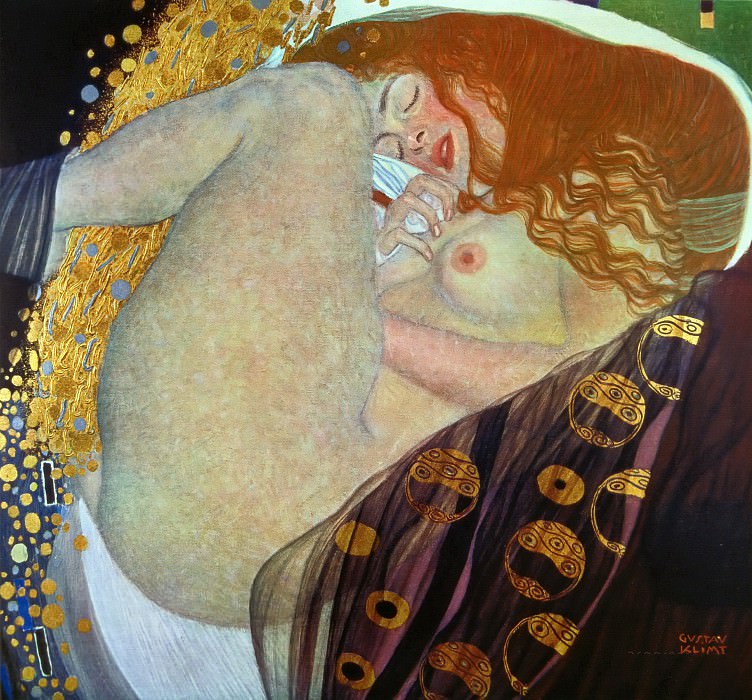Title Danae Gustav Klimt (1862-1918)
Gustav Klimt – Title Danae
Edit attribution
Download full size: 2546×2373 px (1,2 Mb)
Painter: Gustav Klimt
Location: Private Collection
The painting Danaë is one of Austrian artist Gustav Klimt’s most popular mythological works. According to an ancient myth, the beautiful Danaë was imprisoned by her father Arixius in a copper tower. He treated his daughter so severely, trying in every way possible to keep his daughter from giving birth to a son. The famous oracle had earlier predicted the king that he would be killed by his grandson, that is, by the son of Danaë.
Description of Gustav Klimt’s painting Danaë
The painting Danaë is one of Austrian artist Gustav Klimt’s most popular mythological works.
According to an ancient myth, the beautiful Danaë was imprisoned by her father Arixius in a copper tower. He treated his daughter so severely, trying in every way possible to keep his daughter from giving birth to a son. The famous oracle had earlier predicted the king that he would be killed by his grandson, that is, by the son of Danaë. But despite all the measures taken, the destined thing was to come true and god Zeus himself fell in love with charming Danaë.
No doors and walls could stop the strongest thunderer and he, turning into a golden rain, still got to Danaë imprisoned in a copper tower. Subsequently, their son Perseus, unintentionally but fatally killed his grandfather Acrisius.
Of the whole touching plot of love, which had many obstacles and obstacles, Klimt, in his individual vision of the legend, depicted the most intimate episode of the story.
The sensuality of Zeus’ chosen one is conveyed very realistically, in spite of the girl’s half-asleep state. Also, the beauty of the painting is conveyed through other compositional elements along with the artist’s favorite golden color.
Many critics consider Klimt’s painting immoral, but other art connoisseurs, on the contrary, do not protest, noting the peaceful state when contemplating the mythological subject in softened tones.
Кому понравилось
Пожалуйста, подождите
На эту операцию может потребоваться несколько секунд.
Информация появится в новом окне,
если открытие новых окон не запрещено в настройках вашего браузера.
You need to login
Для работы с коллекциями – пожалуйста, войдите в аккаунт (open in new window).

















COMMENTS: 1 Ответы
Даная. худ. Густав Климт
Борис Ханин
Представлен эротический экстаз:
Глаза закрыты, согнутые ноги.
Две груди выставлены напоказ.
Такой Даная удалась немногим.
Здесь все: и эротическая страсть
В позиции Данаи в своем ложе,
И пальцы рук, готовые содрать,
В момент оргазма, собственную кожу.
Глаза закрыты, сладкий стон идет
Из нежных уст ее полуоткрытых.
А между ног Зевс "золотым дождем"
Рождает страсть в местах от нас сокрытых.
Окрас волос способствует тому,
Орнамента узор темнит в картине,
Подчеркивая тела наготу,
А "золото" прекрасно в середине.
И, правда, пошлости в картине нет.
Ценители искусства отмечают
Умиротворение в душе – след
От полотна у тех, кто понимает.
You cannot comment Why?
The composition focuses on Danaes body, rendered with soft, fleshy tones. The background is a symbolic representation of the divine, often interpreted as the golden rain of Zeus, which figures prominently in the myth of Danae. This is depicted through a swirling mass of gold leaf and gold-colored dots, suggesting a rich, opulent, and almost cosmic environment. The use of gold is characteristic of Klimts Golden Phase and imbues the painting with a sense of luxury and sacredness.
Subtexts within the painting are multifold. Primarily, it is an interpretation of the Greek myth of Danae, who was impregnated by Zeus in the form of a shower of gold. However, Klimts depiction is more focused on the sensuality and eroticism of the moment rather than a literal narrative. The closed eyes and the posture can be seen as an embrace of a divine or transcendent experience, possibly sexual in nature. The abundance of gold can symbolize not only divine intervention but also wealth and fertility. The painting can be interpreted as a celebration of feminine sensuality, the awakening of desire, and the mystery of creation. Klimts distinctive style, blending realism with decorative elements and symbolism, creates a tension between the carnal and the spiritual, making Danae a potent exploration of themes related to love, sexuality, and divinity.